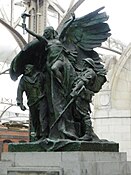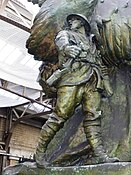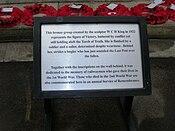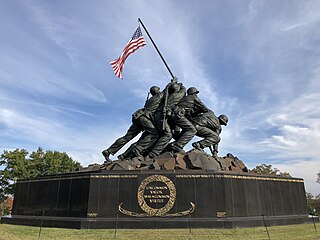
The United States Marine Corps War Memorial is a national memorial located in Arlington County, Virginia. The memorial was dedicated in 1954 to all Marines who have given their lives in defense of the United States since 1775. It is located in Arlington Ridge Park within the George Washington Memorial Parkway, near the Ord-Weitzel Gate to Arlington National Cemetery and the Netherlands Carillon. The memorial was turned over to the National Park Service in 1955.

The Tower Hill Memorial is a pair of Commonwealth War Graves Commission memorials in Trinity Square Gardens, on Tower Hill in London, England. The memorials, one for the First World War and one for the Second, commemorate civilian, merchant seafarers and fishermen who were killed as a result of enemy action and have no known grave. The first, the Mercantile Marine War Memorial, was designed by Sir Edwin Lutyens and unveiled in 1928; the second, the Merchant Seamen's Memorial, was designed by Sir Edward Maufe and unveiled in 1955. A third memorial, commemorating merchant seamen who were killed in the 1982 Falklands War, was added to the site in 2005.

Dover Priory railway station is the southern terminus of the South Eastern Main Line in England, and is the main station serving the town of Dover, Kent, the other open station being Kearsney, on the outskirts. It is 77 miles 26 chains (124.4 km) down the line from London Victoria. The station and all trains that serve the station are operated by Southeastern. This station is a 25 min walk away from the Ferry Port.

The Tugu Negara is a sculpture considered as a national monument that commemorates those who died in Malaysia's struggle for freedom, principally against the Japanese occupation during World War II and the Malayan Emergency, which lasted from 1948 until 1960. It is located in the Federal capital, Kuala Lumpur. The Malaysian Houses of Parliament is situated near the monument.
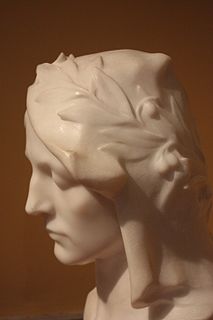
Allan Gairdner Wyon FRBS RMS was a British die-engraver and sculptor and, in later life, vicar in Newlyn, Cornwall.

The Port of Dover is a cross-channel ferry, cruise terminal, maritime cargo and marina facility situated in Dover, Kent, south-east England. It is the nearest English port to France, at just 34 kilometres (21 mi) away, and is one of the world's busiest maritime passenger ports, with 11.7 million passengers, 2.6 million lorries, 2.2 million cars and motorcycles and 80,000 coaches passing through it in 2017, and with an annual turnover of £58.5 million a year. This contrasts with the nearby Channel Tunnel, the only fixed link between the island of Great Britain and the European mainland, which now handles an estimated 20 million passengers and 1.6 million trucks per year.
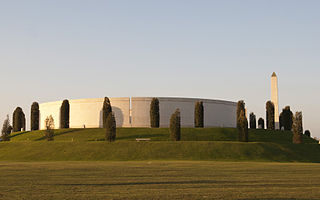
The Armed Forces Memorial is a national memorial in the United Kingdom, dedicated to the 16,000 servicemen and women of the British Armed Forces killed on duty or through terrorist action since after the Second World War. It is within the National Memorial Arboretum in Staffordshire.
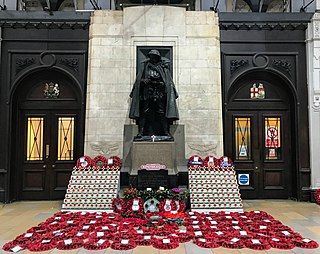
The Great Western Railway War Memorial is a First World War memorial by Charles Sargeant Jagger and Thomas S. Tait. It stands on platform 1 at London Paddington station, commemorating the 2,500 employees of the Great Western Railway (GWR) who were killed in the conflict. One-third of the GWR's workforce of almost 80,000 left to fight in the First World War, the company guaranteeing their jobs, and the GWR gave over its workshops for munitions manufacturing as well as devoting its network to transporting soldiers and military equipment. The company considered several schemes for a war memorial before approaching Jagger to design a statue. Some officials continued to push for an alternate design, to the point that Jagger threatened to resign. Jagger was working on several other war memorial commissions at the same time as the GWR's, including his most famous, the Royal Artillery Memorial.

The National War Memorial is a monument on the north edge of the city centre of Adelaide, South Australia, commemorating those who served in the First World War. Opened in 1931, the memorial is located on the corner of North Terrace and Kintore Avenue, adjacent to the grounds of Government House. Memorial services are held at the site throughout the year, with major services on both Anzac Day (25 April) and Remembrance Day (11 November).
Edward Alfred Briscoe Drury was a British architectural sculptor and artist active in the New Sculpture movement. During a long career Drury created a great number of decorative figures such as busts and statuettes plus larger monuments, war memorials, statues of royalty and architectural pieces. During the opening years of the 20th-century he was among the foremost architectural sculptors active in Britain and in that period created the series of works in central London for which he is perhaps now best known. These include the figures on the Old War Office building in Whitehall, elements of the facade of the Victoria and Albert Museum and four of the colossal statues on Vauxhall Bridge.

The Midland Railway War Memorial is a First World War memorial in Derby in the East Midlands of England. It was designed by Sir Edwin Lutyens and unveiled in 1921. The memorial commemorates employees of the Midland Railway who died while serving in the armed forces during the First World War. The Midland was one of the largest railway companies in Britain in the early 20th century, and the largest employer in Derby, where it had its headquarters. Around a third of the company's workforce, some 23,000 men, left to fight, of whom 2,833 were killed.

Pierre-Marie Poisson was born in Niort on 19 November 1876 and died in Paris on 11 January 1953. He was a French sculptor and medallist.

The Anglo-Belgian Memorial, also known as the Belgian Gratitude Memorial, Belgian Refugees Memorial, or the Belgian Monument to the British Nation, is a war memorial on Victoria Embankment in London, opposite Cleopatra's Needle. It was a gift from Belgium, as a mark of thanks for assistance given by the UK during the First World War, and in particular for sheltering thousands of Belgian refugees who fled from the war. It is a Grade II* listed building.

The London Troops War Memorial, located in front of the Royal Exchange in the City of London, commemorates the men of London who fought in World War I and World War II.

St Saviour's War Memorial is a war memorial on Borough High Street, in the former parish of Southwark St Saviour, to south of the River Thames in London. It became a Grade II listed building in 1998 and was upgraded to Grade II* in 2018.
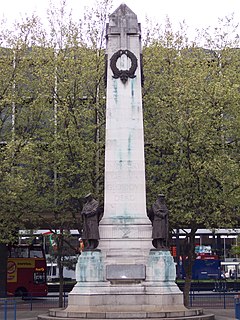
The London and North Western Railway War Memorial is a First World War memorial located outside Euston station in London, England. The memorial was designed by Reginald Wynn Owen, architect to the London and North Western Railway (LNWR), and commemorates employees of the LNWR who were killed in the First World War. Some 37,000 LNWR employees left to fight in the war—around a third of the company's workforce—of whom over 3,000 were killed. As well as personnel, much of the company's infrastructure was turned over to the war effort. Of the £12,500 cost of the memorial, £4,000 was contributed by the employees and the company paid the remainder.
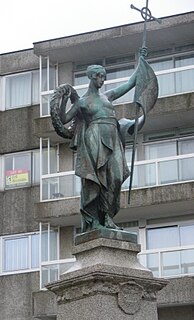
Folkestone War Memorial is a First World War memorial situated in The Leas area of Folkestone, Kent. Designed by Ferdinand Victor Blundstone and unveiled in 1922, it commemorates the 578 men of Folkestone who served in the war, and those who passed through Folkestone Harbour when Folkestone Harbour railway station nearby was an important point of departure and return for passage to the Western Front via Boulogne. The road from the station to the harbour was renamed the "Road of Remembrance" after the war.

Kingston upon Thames War Memorial, in the Memorial Garden on Union Street, Kingston upon Thames, London, commemorates the men of the town who died in the First World War. After 1945, the memorial was updated to recognise casualties from the Second World War. The memorial was commissioned by the town council and was designed by the British sculptor Richard Reginald Goulden. The memorial includes a bronze statue of a nude warrior, carrying a flaming cross and wielding a sword with which he defends two children from a serpent, erected on a granite plinth, with bronze plaques listing the names of the dead. Goulden designed a number of such allegorical memorials, including others at Crompton, Greater Manchester, and Redhill, Surrey. The Kingston memorial was designated a Grade II listed structure in 1983. This was revised upwards in 2016 to Grade II*, denoting a building or structure of particular importance.


